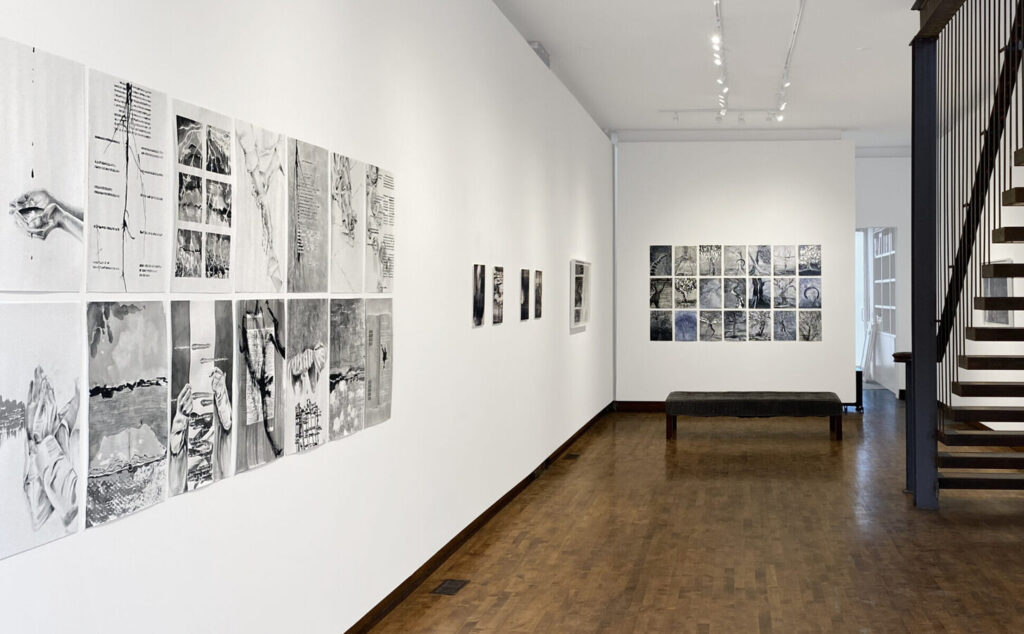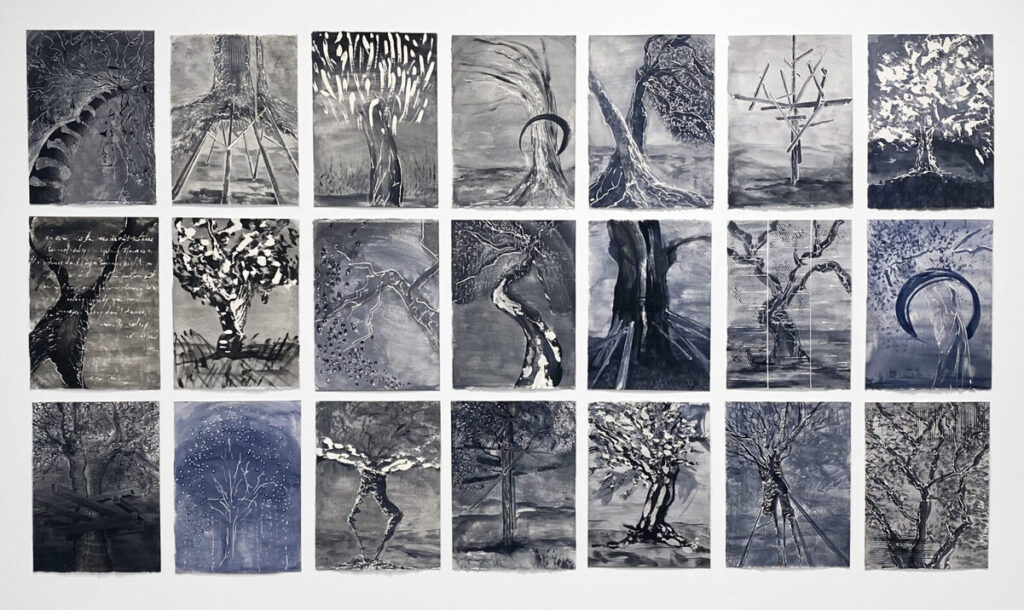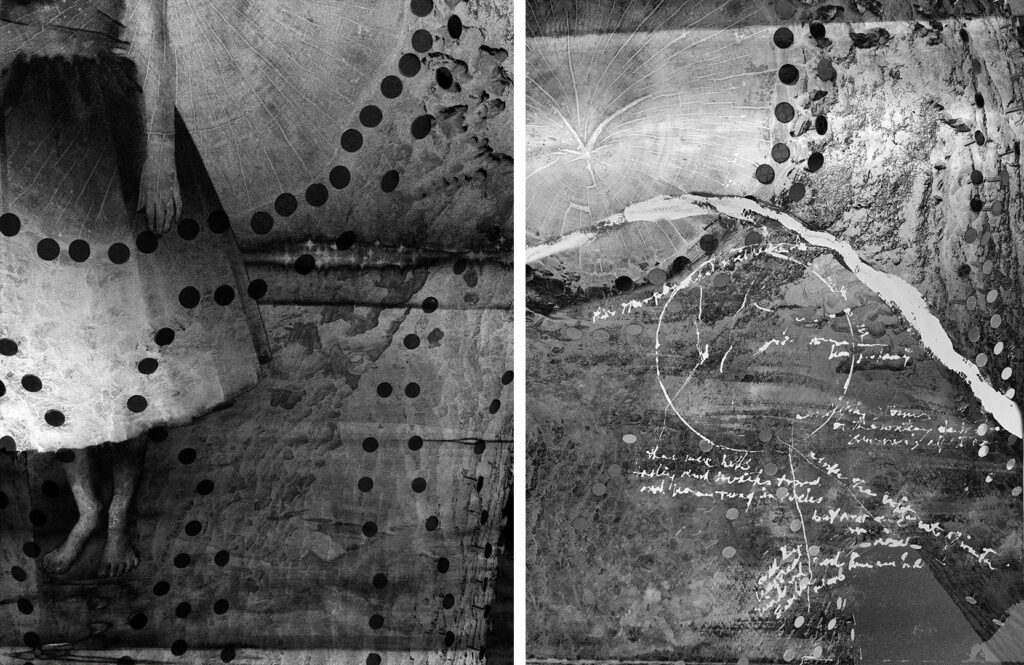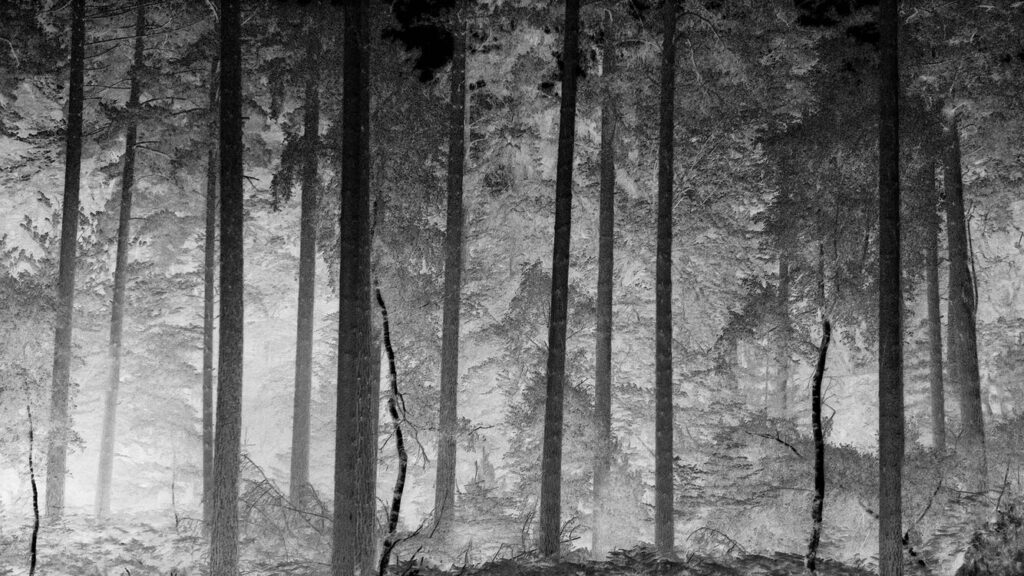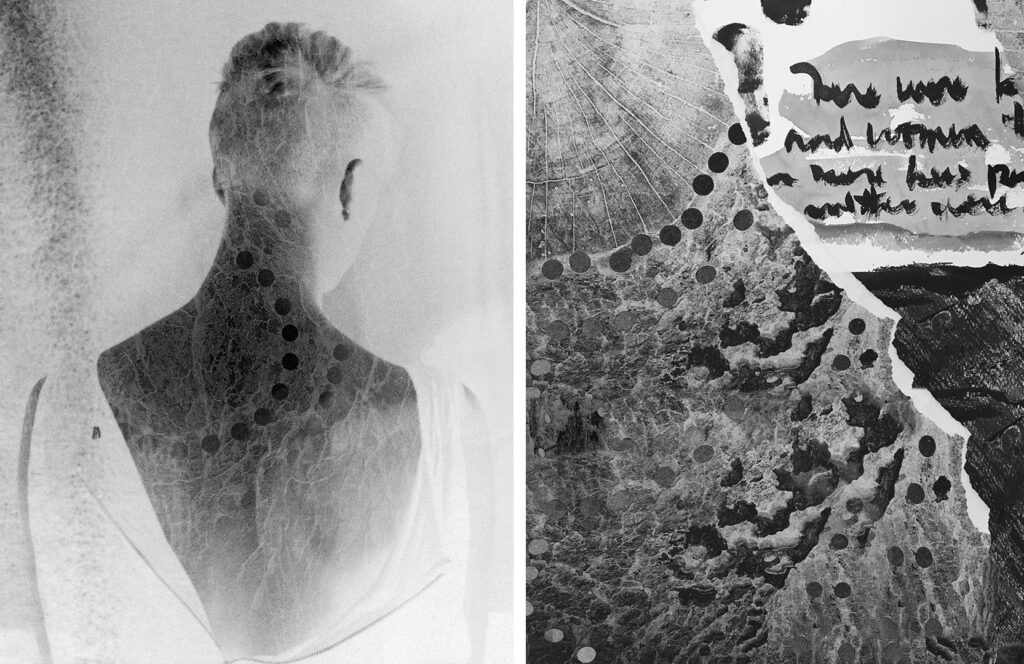Joan Kaufman has been spending time in the forest. The experience has inspired her latest work on display at Lonsdale Gallery. It is a collection of drawings and photo-based art, all more or less in black and white. The two main works in the show are grids, or suites, of what she calls ‘acrylic drawings’ on paper, titled Weather Report and Field Notes. As drawings, these are a bit of a departure from Kaufman’s usual practice of photo-based work. Why the change? She explains that for this work it was imperative that she express herself directly, unmediated. Working with cameras etc., made her feel ‘somewhat removed from the actual work’ and so she needed to eliminate these intervening technologies.
Joan Kaufman, Forest Diaries, exhibition view
These comments are reminiscent of the words of Jerry Mander, a preeminent advertiser in the sixties and seventies, who began to see television as a threat to humanity. What he had to say in his book outlining his ‘arguments for the elimination of television’ seem even more salient regarding contemporary digital technologies. He argued that our experiences had become almost completely mediated, and he went on to remark: “When we are walking in a forest, we can see and feel what the planet produces directly…It is not mediated, interpreted or altered.” (Mander, 1978, p. 55) the irony of course is that today not only are our experiences of nature mediated, but all of nature itself has been altered by us. Indeed, we have killed it, to paraphrase author Bill McKibben.
Kaufman is clearly aware of the predicament characterized above. We are told that her “original drawings offer the viewer a provocative reminiscence exploring human intervention onto the natural world.” Her Weather Report aims, no less, to express our anxiety about climate change. She does this through quasi-apocalyptic imagery – suggesting storms, plagues, floods, exhortations and so on – whose compositions are often interrupted by jarring pseudo-writing, that alludes to warnings of climate catastrophe. The suite’s composition is masterful. She explains that she starts off with an overall concept about how the piece will look, and then sets about making each drawing accordingly. Occasionally a drawing is put aside and placed somewhere else in the grid.
Weather Report, 2021, charcoal & acrylic drawings on Fabriano watercolour paper, 20 drawings, each 22 x 15 inches
Her second suite of drawings, Field Notes, is a different beast. Each drawing doesn’t stand alone to the same degree that the drawings in Weather Report do. The overall composition is more integrated in this sense. It reads as a sort of dance macabre featuring trees rather than skeletons. The trees, standing under brooding skies, are contorted, sometimes teetering skeletal-like on stilts, or nailed together like a makeshift crucifix.
Field Notes, 2022, acrylic drawings on Fabriano watercolour paper, 21 drawings, each 15 x 11 inches
The other works in the show are photo-based works. First is a series of eight works titled Traces features images of an old tree trunk with nails embedded in it. These images are mostly juxtaposed with close-ups of human bodies to suggest violence, namely, our violent actions towards nature.
Traces 6 (left) and Traces 7 (right), both 2021, photo pigment print, 15 x 11 inches
The final piece is a spectral image of a forest aptly titled Ghost Forest.
Ghost Forest 1, 2022, photo lustre pigment print, 22.5 x 40 inches
Let me say a little more about Kaufman’s shift away from the mediated image. It is interesting how the technology of photography has enabled us to perceive nature far more accurately. This accuracy has given us a fuller understanding of the natural world. The same holds true for other technologies, of course, such as microscopes, telescopes and cinematography. But ironically this understanding is in an important sense superficial. To return to Mander, he notes that scientific technologies enable us to know, for example, how precisely fruits grow. But, Mander writes: “…we can’t really ‘know’ what it means, or how a whole cycle is operating…Nor do we see particular value in this knowledge…Therefore we don’t develop a feeling about it, a caring.” (ibid, p. 56) His point is that we have replaced one type of understanding of nature – a direct acquaintance with it – for another, namely, an abstract scientific understanding of nature, which does not foster a deep appreciation of it. We fail to lament the loss of the former knowledge of nature because we have an inflated faith in the scientific knowledge. Consequently, we ‘know’ in a scientific sense that the climate is radically changing, but we do not appreciate these changes insofar as they are largely an abstraction vis-à-vis our everyday lives.
I see Kaufman’s show as a sort of cri de coeur. She is pointing out to the viewer how we lack this direct acquaintance with nature. And her own attempts to become reacquainted with it impel her to discard her digital tools of the trade, and express her immediate experiences of it. For this reason I find her drawings far more impactful than her photo-based works in this show. They feel less contrived, more honest in the expression of her lament for nature.
Traces 9 (left) and Traces 8 (right), both 2021, photo pigment print, 15 x 11 inches
That said, Kaufman has had an abiding interest in the body. The body has always been central to her work. Indeed, it was a return to figure drawing years ago that ultimately led to her choice of medium for this show. And it is clear that, generally speaking, the body is in a crucial way the last sanctuary of nature in our everyday lives. This, I think, helps to explain her use of violence to the bottom in her Traces. The body is not simply a stand in for the natural world, that we are in the process of destroying, but is part of nature. Over all, this is a thoughtful, well-curated show, that is genuinely moving. A jewel.
Hugh Alcock
Images are courtesy of Lonsdale Gallery
*Exhibition information: Joan Kaufman, Forest Diaries, October 22 – November 29, 2022, Lonsdale Gallery, 410 Spadina Rd, Toronto. Gallery hours: Wed – Sat, 11am – 6pm.

